Bioclimatic Classification of Northeast Asia Reflecting Social Factors: Development and Characterization
Abstract
:1. Introduction
2. Data and Method
2.1. Study Area (Northeast Asia)
2.2. Definition of Bioclimatic Classification
2.3. Bioclimatic Variables and Data
2.4. Construction Method for Bioclimatic Zones
2.4.1. Selecting Bioclimatic Variables
2.4.2. Selecting Socio-Spatial Variables
2.4.3. Clustering
2.4.4. Nomination and Characterization
3. Results and Discussion
3.1. Selecting Variables of NEA
3.2. Bioclimatic Classification of NEA
3.3. Environmental Characteristics of Bioclimatic Zones (Response of Land Cover)
3.4. Assessment of Bioclimatic Classification by Qualitative Interpretation
3.5. Implications and Limitations
4. Conclusions
Supplementary Materials
Acknowledgments
Author Contributions
Conflicts of Interest
Nomenclature
| Dry Crop-Grassland (AdA) | The AdA zone is a region with low naturality, which is composed of about 50% cropland and 26% grassland. It surrounds the Bohai Bay, and many Chinese coastal cities are adjacent to it. Annual mean temperatures are higher than those in the northern part of NEA, but the amount of precipitation is relatively low. Therefore, this zone is dry and has low precipitation effectiveness. |
| Dry Crop-Shrubland (AdB) | The AdB zone is a region where about 50% of the area within the zone is cropland and about 50% shrubland, so naturality is low. This zone is widely distributed in the northern part of NEA and is a low-altitude plain area. It is located in the northern inland area, thus it has a continental climate, which is represented by low annual mean temperature, low precipitation, and very high levels of PET. |
| Dry Mixed Forest (NdB) | The NdB zone is a high naturality region with a mixture of needleleaf and deciduous forests. It includes the largest area of forest among all zones. It occupies a large area in the northern part of NEA. Although it is a dry area, the PEI is high because of the low temperature. |
| Dry Natural Area (NdC) | The NdC zone is a high naturality region with a wide distribution of water, needleleaf forest, and mixed forest. It is scattered sporadically in the central part of NEA, including the eastern coast and the Kyongsang basin in the southern part of the Korean Peninsula and the Bohai Bay in China. It is classified as a dry zone, but it is relatively wet. Moreover, it shows boundary-level climate between the ocean and the inland in terms of seasonality and precipitation effectiveness. |
| Dry Woodland (NdA) | The NdA zone is where most of the deciduous needleleaf forest is distributed. In this zone, woodland occupies the largest area, so naturality is high. It is an inland forest area in north NEA with low temperature and low precipitation. As a result, seasonal fluctuation of PET is high, similar to the AaA zone. |
| Moist Built-up Area (AmF) | The AmF zone is the region with the lowest naturality, as it includes the major metropolitan areas of NEA (Shanghai in China, Seoul in South Korea, Pyongyang in North Korea, and Osaka in Japan). The annual mean temperature is the highest, and the altitude is the lowest. |
| Moist Cropland (AmC) | The AmC zone is a region with low naturality because of the high percentage of cropland. It is the representative granary zone of NEA. It covers the western plains of the Korean Peninsula and the North China Plain and surrounds the Yellow Sea. The average altitude is low because it includes many plains. Located in the south-central part of NEA, the annual mean temperature is high and the PEI is low. |
| Moist Mixed Forest (NmE) | The NmE zone is a highland region that includes the Kuma Plateau in the northern part of the Korean peninsula, the Sikhote-Alin Mountains in Russia, and Mt. Hotakake and Mt. Ontake in Japan. As a result, the altitude is the highest and the annual mean temperature is the lowest. In addition, it is wet and has the highest PEI. Most areas in this zone are made up of forests, with mixed forests accounting for about 40%. |
| Moist Natural Area (NmD) | The NmD zone is a region of high naturality that includes water, needleleaf forest, and woodland in similar proportions. This zone includes the northern and southern regions leading from the Maritime Provinces (Russia) to the northeastern part of NEA to the low mountains of the Korean Peninsula and the watersheds of the Yangtze River Basin. It includes several regions distributed over various latitudes, and thus exhibits a moderate level of environmental characteristics such as mean temperature and precipitation. |
| Moist Shrub-Bare Land (AmB) | The AmB zone is composed of about 40% closed shrubland and 40% bare land, so the proportion of natural area is low. This zone is a large shrub-bare land area located between the Liaodong Peninsula and Amnok River and is in a relatively high altitude area. Although the annual mean temperature is lower than that of the surrounding areas, it is relatively wet with high precipitation. |
| Semi-arid Cropland (AaA) | The AaA zone is a low naturality area, mostly composed of croplands. It is widely distributed in northwest NEA and is mostly affected by continental climate. It is located the most inland of the zones, therefore it has the highest seasonality and the average altitude is relatively high. It is the driest zone, adjacent to Chinese and Mongolian inland deserts, and has less than 500 mm of annual precipitation. |
| Wet Artificial Area (AwG) | The AwG zone is a region that includes grassland, cropland, and built-up areas, and similar to the AmF zone, its naturality is low. It is sporadically distributed near the southern part of NEA, with the annual mean temperature and precipitation the second highest among the zones. |
| Wet Evergreen Forest (NwG) | The NwG zone is the region that contains the most evergreen needleleaf forest, and its naturality is high. It includes most of the southern forest area of NEA and has a high average altitude. Because it is located in the southern coastal region, it has the highest annual precipitation and the lowest PET seasonality and is the wettest region among all zones. |
| Wet Mixed Forest (NwD) | The NwD zone includes the major mountains of the Korean Peninsula and southern coast of the Maritime Provinces, and its naturality is high because of the high proportion of mixed forests. Despite being located at low latitudes, the mean annual temperature is low because it contains many high-altitude mountains. |
References
- Tittensor, D.P.; Walpole, M.; Hill, S.L.L.; Boyce, D.G.; Britten, G.L.; Burgess, N.D.; Butchart, S.H.M.; Leadley, P.; Regan, E.C.; Alkemade, R.; et al. A mid-term analysis of progress toward international biodiversity targets. Science 2014, 346, 241–244. [Google Scholar] [CrossRef] [PubMed]
- Oliver, T.H.; Heard, M.S.; Isaac, N.J.B.; Roy, D.B.; Procter, D.; Eigenbrod, F.; Freckleton, R.; Hector, A.; Orme, C.D.L.; Petchey, O.L.; et al. Biodiversity and resilience of ecosystem functions. Trends Ecol. Evol. 2015, 30, 673–684. [Google Scholar] [CrossRef] [PubMed]
- Folke, C.; Carpenter, S.; Walker, B.; Scheffer, M.; Elmqvist, T.; Gunderson, L.; Holling, C.S. Regime shifts, resilience, and biodiversity in ecosystem management. Annu. Rev. Ecol. Evol. Syst. 2004, 35, 557–581. [Google Scholar] [CrossRef]
- Cardinale, B.J.; Duffy, J.E.; Gonzalez, A.; Hooper, D.U.; Perrings, C.; Venail, P.; Narwani, A.; Mace, G.M.; Tilman, D.; Wardle, D.A.; et al. Biodiversity loss and its impact on humanity. Nature 2012, 489, 326. [Google Scholar] [CrossRef]
- Díaz, S.; Fargione, J.; Chapin, F.S.; Tilman, D. Biodiversity Loss Threatens Human Well-Being. PLoS Biol. 2006, 4, e277. [Google Scholar] [CrossRef] [PubMed]
- Butchart, S.H.M.; Walpole, M.; Collen, B.; van Strien, A.; Scharlemann, J.P.W.; Almond, R.E.A.; Baillie, J.E.M.; Bomhard, B.; Brown, C.; Bruno, J.; et al. Global Biodiversity: Indicators of Recent Declines. Science 2010, 328, 1164–1168. [Google Scholar] [CrossRef] [PubMed]
- Araújo, M.B.; Pearson, R.G.; Thuiller, W.; Erhard, M. Validation of species-climate impact models under climate change. Glob. Chang. Biol. 2005, 11, 1504–1513. [Google Scholar] [CrossRef]
- Stokes, D.L.; Hanson, M.F.; Oaks, D.D.; Straub, J.E.; Ponio, A.V. Local land-use planning to conserve biodiversity: Planners’ perspectives on what works. Conserv. Biol. 2010, 24, 450–460. [Google Scholar] [CrossRef] [PubMed]
- Harding, J.S.; Winterbourn, M.J. An ecoregion classification of the South Island, New Zealand. J. Environ. Manag. 1997, 51, 275–287. [Google Scholar] [CrossRef]
- McMahon, G.; Gregonis, S.M.; Waltman, S.W.; Omernik, J.M.; Thorson, T.D.; Freeouf, J.A.; Rorick, A.H.; Keys, J.E. Developing a spatial framework of common ecological regions for the conterminous United States. Environ. Manag. 2001, 28, 293–316. [Google Scholar] [CrossRef]
- Leathwick, J.R.; Overton, J.; McLeod, M. An environmental domain classification of New Zealand and its use as a tool for biodiversity management. Conserv. Biol. 2003, 17, 1612–1623. [Google Scholar] [CrossRef]
- Awimbo, J.A.; Norton, D.A.; Overmars, F.B. An evaluation of representativeness for nature conservation, Hokitika Ecological District, New Zealand. Biol. Conserv. 1996, 75, 177–186. [Google Scholar] [CrossRef]
- Margules, C.R.; Pressey, R.L. Systematic conservation planning. Nature 2000, 405, 243–253. [Google Scholar] [CrossRef] [PubMed]
- Metzger, M.J.; Brus, D.J.; Bunce, R.G.H.; Carey, P.D.; Gonçalves, J.; Honrado, J.P.; Jongman, R.H.G.; Trabucco, A.; Zomer, R. Environmental stratifications as the basis for national, European and global ecological monitoring. Ecol. Indic. 2013, 33, 26–35. [Google Scholar] [CrossRef]
- Hossell, J.E.; Riding, A.E.; Brown, I. The creation and characterisation of a bioclimatic classification for Britain and Ireland. J. Nat. Conserv. 2003, 11, 5–13. [Google Scholar] [CrossRef]
- Metzger, M.J.; Bunce, R.G.H.; Jongman, R.H.G.; Mücher, C.A.; Watkins, J.W. A climatic stratification of the environment of Europe. Glob. Ecol. Biogeogr. 2005, 14, 549–563. [Google Scholar] [CrossRef]
- Omernik, J.M.; Griffith, G.E. Ecoregions of the conterminous United States: Evolution of a hierarchical spatial framework. Environ. Manag. 2014, 54, 1249–1266. [Google Scholar] [CrossRef] [PubMed]
- Haines-Young, R. Land use and biodiversity relationships. Land Use Policy 2009, 26, S178–S186. [Google Scholar] [CrossRef]
- Firbank, L.G.; Petit, S.; Smart, S.; Blain, A.; Fuller, R.J. Assessing the impacts of agricultural intensification on biodiversity: A British perspective. Philos. Trans. R. Soc. B Biol. Sci. 2008, 363, 777–787. [Google Scholar] [CrossRef] [PubMed]
- Parr, T.W.; Sier, A.R.; Battarbee, R.W.; Mackay, A.; Burgess, J. Detecting environmental change: Science and society—Perspectives on long-term research and monitoring in the 21st century. Sci. Total Environ. 2003, 310, 1–8. [Google Scholar] [CrossRef]
- Davidson, M.D. Equity and the Conservation of Global Ecosystem Services. Sustainability 2017, 9, 339. [Google Scholar] [CrossRef]
- Shim, C.S.; Oh, I.C.; Rho, T.H.; Seo, J.H.; Kim, Y.W.; Park, C.H. A study on the environmental change in East Asia (I): Atmospheric change and biodiversity. Korea Environ. Inst. 2014, 17, 49–68. [Google Scholar]
- Lugo, A.E.; Brown, S.B.; Dodson, R.; Smith, T.S.; Shugart, H.H. The Holdridge life zones of the conterminous United States in relation to ecosystem mapping. J. Biogeogr. 1999, 26, 1025–1038. [Google Scholar] [CrossRef]
- Metzger, M.J.; Bunce, R.G.H.; Jongman, R.H.G.; Sayre, R.; Trabucco, A.; Zomer, R. A high-resolution bioclimate map of the world: A unifying framework for global biodiversity research and monitoring. Glob. Ecol. Biogeogr. 2013, 22, 630–638. [Google Scholar] [CrossRef]
- Jongman, R.H.; Bunce, R.G.; Metzger, M.J.; Mücher, C.A.; Howard, D.C.; Mateus, V.L. Objectives and applications of a statistical environmental stratification of Europe. Landsc. Ecol. 2006, 21, 409–419. [Google Scholar] [CrossRef]
- Jeon, S.W.; Byun, B.S.; Lee, B.J. A basic plan for environmental preservation of DMZ members. Basic Res. Rep. 2003, 2003, 1–20. [Google Scholar]
- Park, Y.Y.; Han, K.S. Ecoclimatic map over North-East Asia using SPOT/VEGETATION 10-day synthesis data. Korean J. Agric. For. Meteorol. 2006, 8, 86–96. [Google Scholar]
- O’Donnel, M.S.; Ignizio, D.A. Bioclimatic Predictors for Supporting Ecological Applications in the Conterminous United States; U.S. Geological Survey: Reston, VA, USA, 2012.
- Hijmans, R.J.; Cameron, S.; Parra, J.; Jones, P.; Jarvis, A.; Richardson, K. WorldClim, version 1.3; University of California: Berkeley, CA, USA, 2005. [Google Scholar]
- Zomer, R.J.; Trabucco, A.; Bossio, D.A.; Verchot, L.V. Climate change mitigation: A spatial analysis of global land suitability for clean development mechanism afforestation and reforestation. Agric. Ecosyst. Environ. 2008, 126, 67–80. [Google Scholar] [CrossRef]
- Jarvis, A.; Reuter, H.I.; Nelson, A.; Guevara, E. Hole-filled SRTM for the Globe Version 4, Available from the CGIAR-CSI SRTM 90m Database. Available online: http://srtm.csi.cgiar.org (accessed on 15 December 2016).
- Langaas, S. Completeness of the Digital Chart of the World (DCW) Database; UNEP/GRID: Arendal, Norway, 1995. [Google Scholar]
- Dunbar, P.K.; Bilham, R.G.; Laituri, M.J. Earthquake loss estimation for India based on macroeconomic indicators. Risk Sci. Sustain. 2003, 112, 163–180. [Google Scholar]
- Dobson, J.E. LandScan Global Population 1998 Database, 1999. Retrieved 27 April 2001 from the World Wide Web. Available online: http://web.ornl.gov/sci/landscan/landscan_data_avail.shtml (accessed on 15 November 2016).
- Lee, K.; Lee, B.W.; Choi, D.-H.; Kim, T.-O.; Shin, D. A study on fault detection monitoring and diagnosis system of CNG stations based on principal component analysis (PCA). J. Korean Inst. Gas. 2014, 18, 53–59. [Google Scholar] [CrossRef]
- Yoo, J.Y.; Choi, M.H.; Kim, T.W. Spatial analysis of drought characteristics in Korea using cluster analysis. J. Korea Water Resour. Assoc. 2010, 43, 15–24. [Google Scholar] [CrossRef]
- Zomer, R.J.; Trabucco, A.; Metzger, M.J.; Wang, M.; Oli, K.P.; Xu, J. Projected climate change impacts on spatial distribution of bioclimatic zones and ecoregions within the Kailash Sacred Landscape of China, India, Nepal. Clim. Chang. 2014, 125, 445–460. [Google Scholar] [CrossRef]
- Thornthwaite, C.W. The climates of North America: According to a new classification. Geogr. Rev. 1931, 21, 633–655. [Google Scholar] [CrossRef]
- Clergeau, P.; Savard, J.P.L.; Mennechez, G.; Falardeau, G. Bird abundance and diversity along an urban-rural gradient: A comparative study between two cities on different continents. Condor 1998, 100, 413–425. [Google Scholar] [CrossRef]
- Blair, R.B. Birds and butterflies along an urban gradient: Surrogate taxa for assessing biodiversity? Ecol. Appl. 1999, 9, 164–170. [Google Scholar] [CrossRef]
- McKinney, M.L. Urbanization, biodiversity, and conservation. BioScience 2002, 52, 883–890. [Google Scholar] [CrossRef]
- Pimentel, D.; Stachow, U.; Takacs, D.A.; Brubaker, H.W.; Dumas, A.R.; Meaney, J.J.; Oneil, J.A.S.; Onsi, D.E.; Corzilius, D.B. Conserving biological diversity in agricultural forestry systems: Most biological diversity exists in human-managed ecosystems. BioScience 1992, 42, 354–362. [Google Scholar] [CrossRef]
- Vitousek, P.M.; Mooney, H.A.; Lubchenco, J.; Melillo, J.M. Human domination of Earth’s ecosystems. Science 1997, 277, 494–499. [Google Scholar] [CrossRef]
- Vitousek, P.M.; Ehrlich, P.R.; Ehrlich, A.E.; Matson, P.A. Human appropriation of the products of photosynthesis. BioScience 1986, 36, 368–373. [Google Scholar] [CrossRef]
- Pimm, S.L. The World According to Pimm; McGraw-Hill: New York, NY, USA, 2001. [Google Scholar]
- Yu, M.; Ellis, J.E.; Epstein, H.E. Regional analysis of climate, primary production, and livestock density in Inner Mongolia. J. Environ. Qual. 2004, 33, 1675–1681. [Google Scholar] [CrossRef] [PubMed]
- Lee, S.; Heo, I.; Lee, K.; Kwon, W. Classification of Local Climatic Regions in Korea. Korean Meteorol. Soc. 2005, 41, 983–995. [Google Scholar]

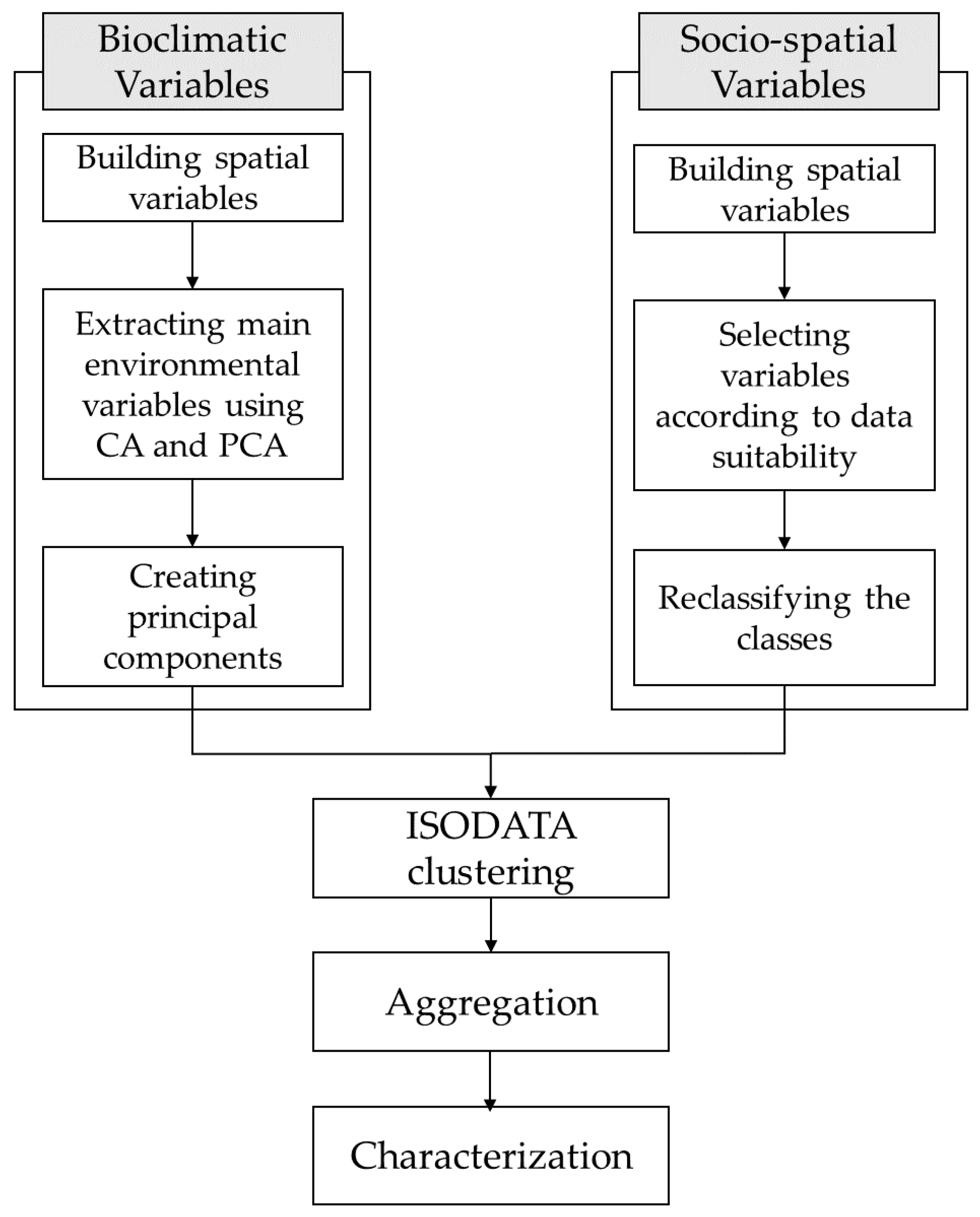
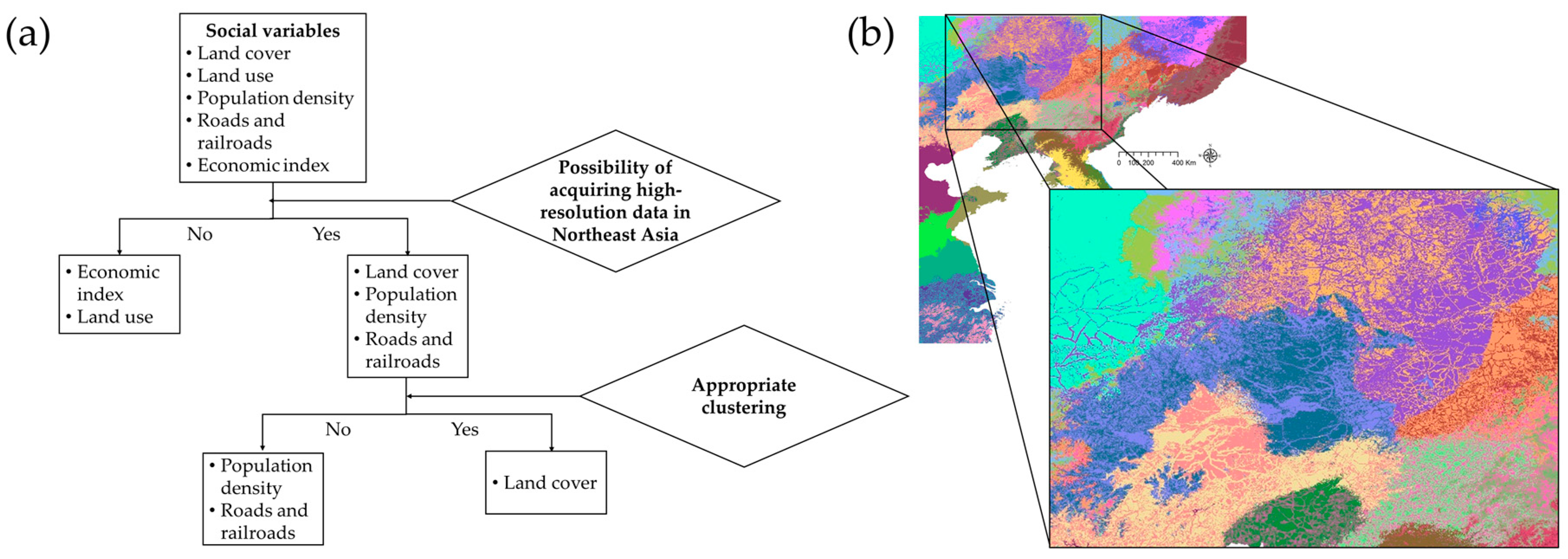
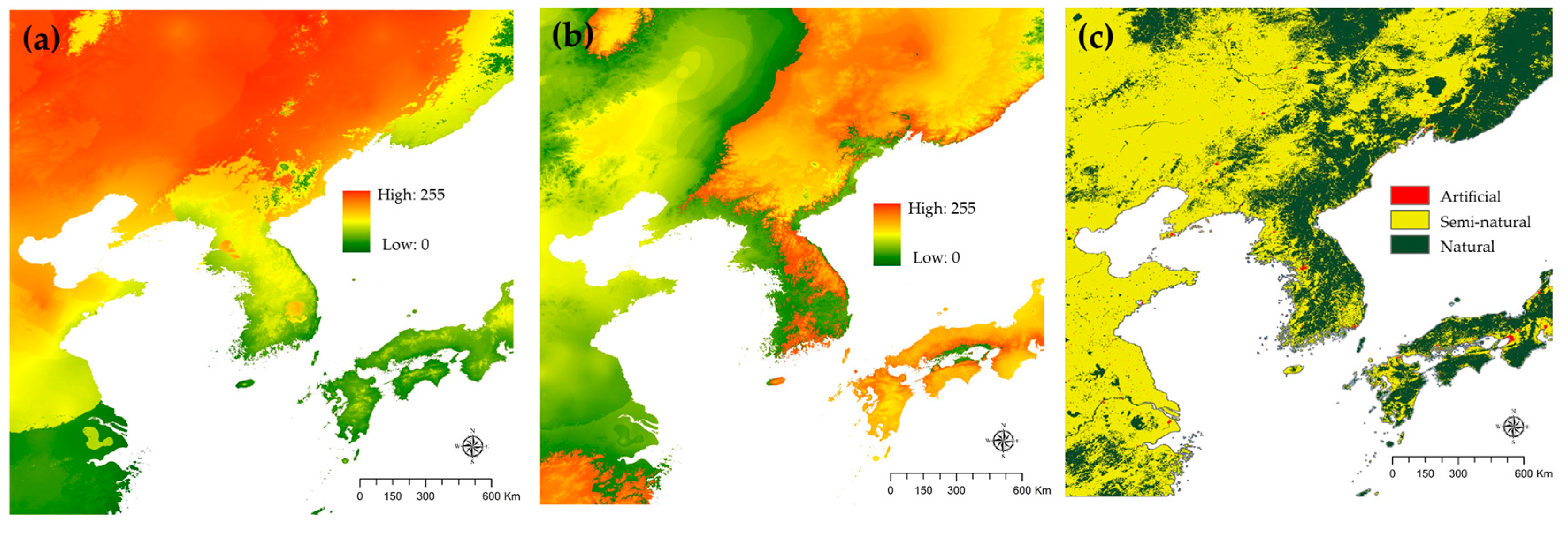
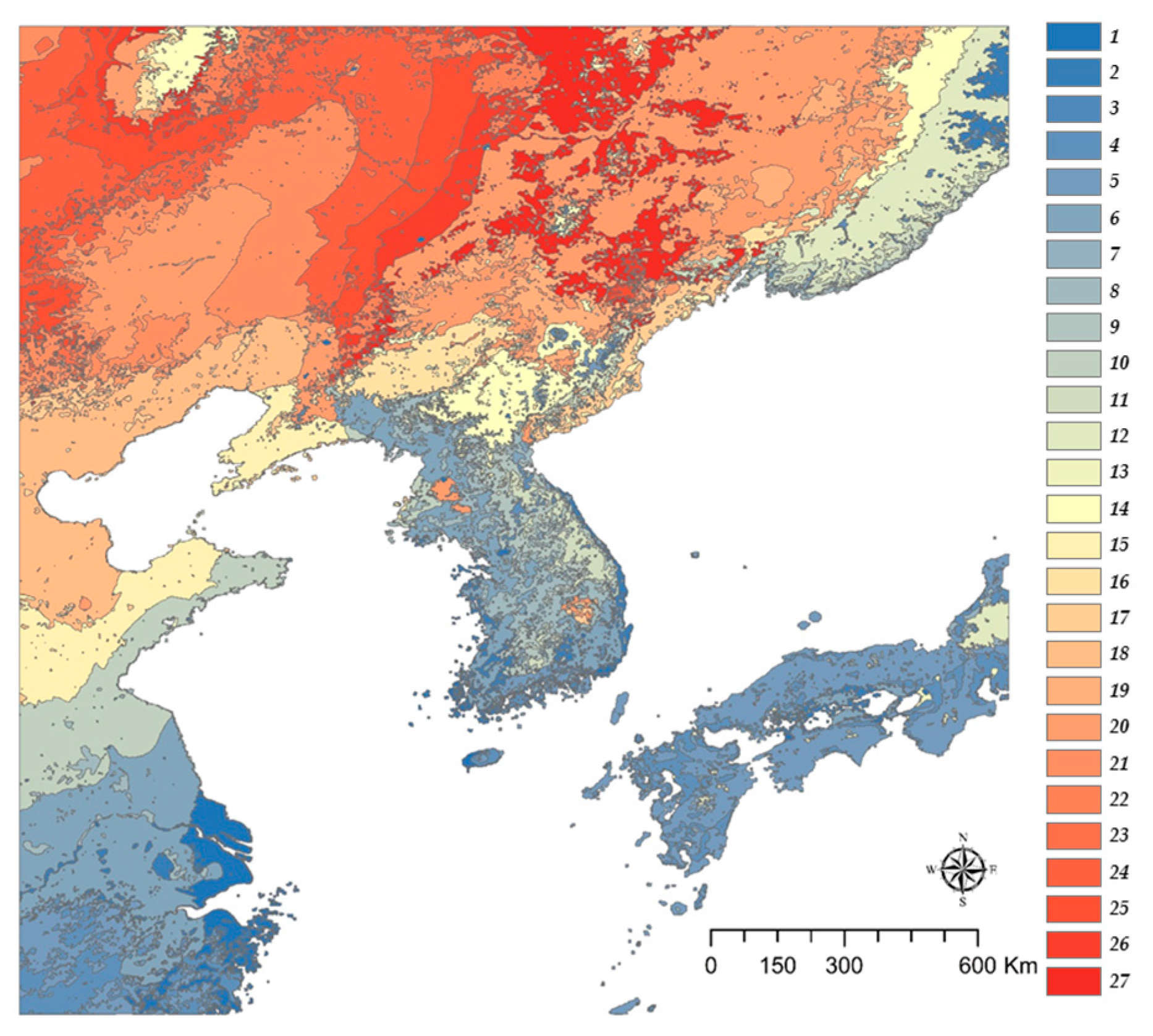
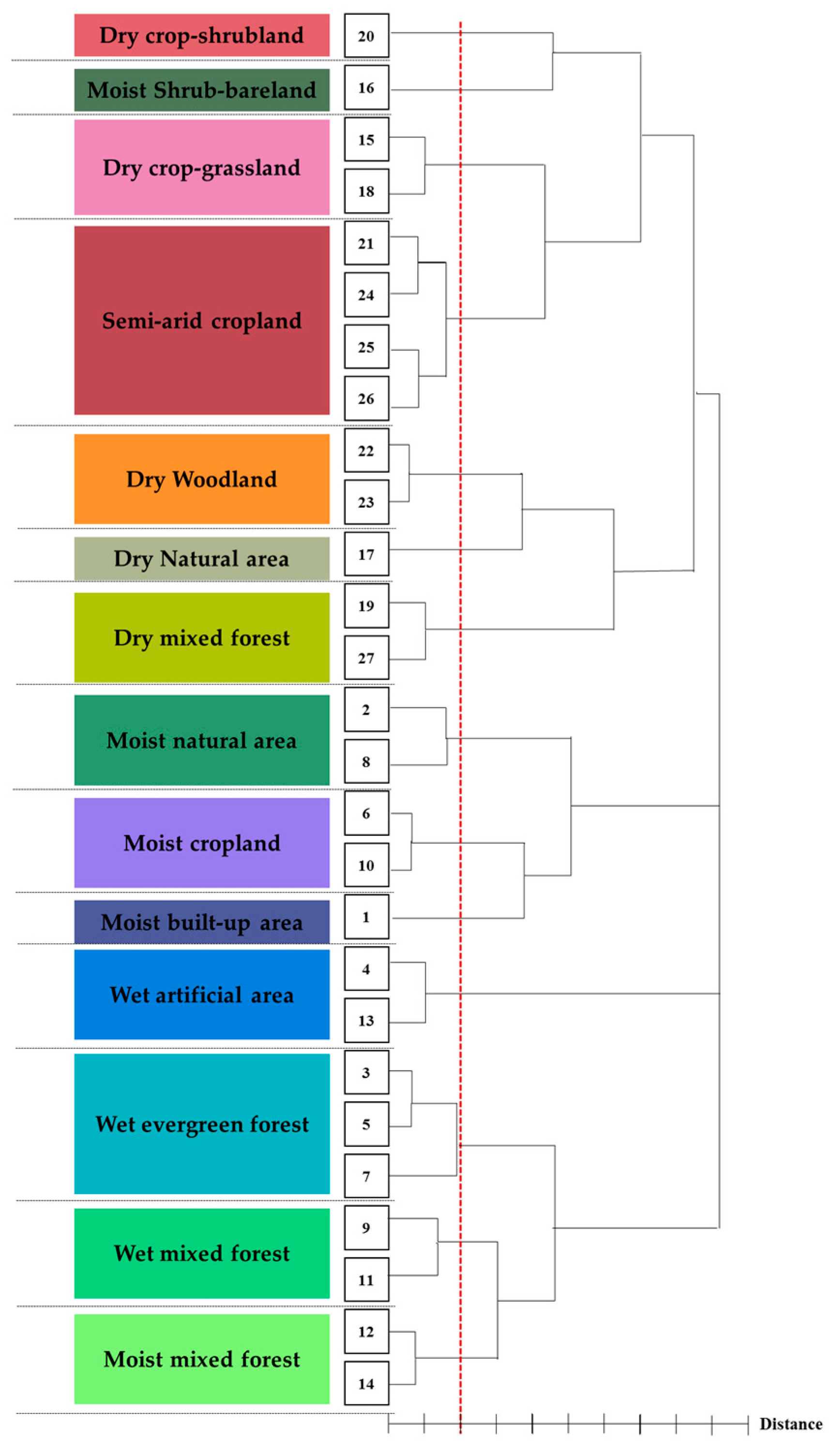

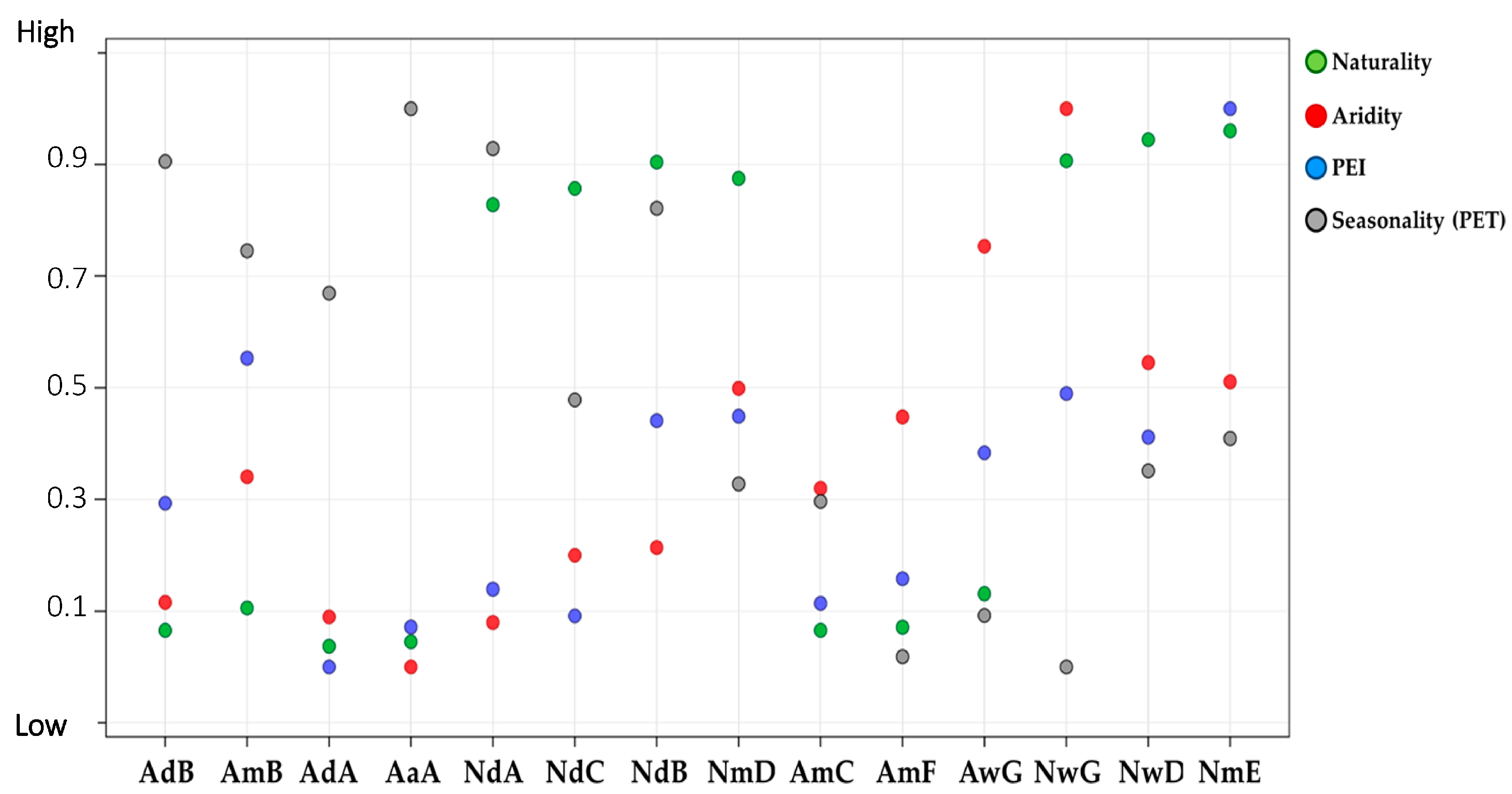

| PC1 | PC2 | ||
|---|---|---|---|
| Standard deviation | 1.26 | 1.00 | |
| Proportion of variance | 0.53 | 0.33 | |
| Cumulative proportion | 0.53 | 0.86 | |
| Var36 | Aridity index | 0.71 | −0.05 |
| Var37 | Potential evapotranspiration seasonality | 0.71 | 0.02 |
| Var48 | Precipitation effectiveness index | 0.02 | 0.99 |
| Index | Criterion | Label |
|---|---|---|
| Land cover ratio | Nature area >80% | Natural (N) |
| Nature area <80% | Artificial (A) | |
| Aridity index | [0–0.6) | Semi-arid (a) |
| [0.6–1.0) | Dry (d) | |
| [1.0–1.3) | Moist (m) | |
| [1.3–) | Wet (w) | |
| Potential evapotranspiration seasonality | (–4500) | Oceanic |
| [4500–5000) | Semi-continental | |
| [5000–) | Continental | |
| Precipitation Effectiveness Index | (0–100) | Low precipitation efficiency |
| [100–200) | Mid precipitation efficiency | |
| [200–300) | High precipitation efficiency |
| Criterion | Label |
|---|---|
| Continental and Low precipitation efficiency | A |
| Continental and Mid precipitation efficiency | B |
| Semi-continental and Low precipitation efficiency | C |
| Semi-continental and Mid precipitation efficiency | D |
| Semi-continental and High precipitation efficiency | E |
| Oceanic and Low precipitation efficiency | F |
| Oceanic and Mid precipitation efficiency | G |
| Code | Name | Zone |
|---|---|---|
| AdB | Dry crop-shrubland | 20 |
| AmB | Moist shrub-bare land | 16 |
| AdA | Dry crop-grassland | 15, 18 |
| AaA | Semi-arid cropland | 21, 24, 25, 26 |
| NdA | Dry woodland | 22, 23 |
| NdC | Dry natural area | 17 |
| NdB | Dry mixed forest | 19, 27 |
| NmD | Moist natural area | 2, 8 |
| AmC | Moist cropland | 6, 10 |
| AmF | Moist built-up area | 1 |
| AwG | Wet artificial area | 4, 13 |
| NwG | Wet evergreen forest | 3, 5, 7 |
| NwD | Wet mixed forest | 9, 11 |
| NmE | Moist mixed forest | 12, 14 |
| Group | Code | Annual Mean Temp. (°C ) | Annual Mean Precipitation (mm/y) | Mean Altitude (m) | Land Cover (% of Area Occupied in the Zone) |
|---|---|---|---|---|---|
| Dry crop-shrubland | AdB | 4.04 | 576.36 | 293.39 | Cropland 48% Wooded grassland 24% Grassland 17% |
| Moist shrub-bare land | AmB | 3.66 | 861.70 | 584.03 | Closed shrubland 40% Bare land 39% Wooded grassland 9% |
| Dry crop-grassland | AdA | 10.95 | 667.31 | 118.55 | Cropland 50% Grassland 26% Wooded grassland 15% |
| Semi-arid cropland | AaA | 3.34 | 457.08 | 458.05 | Cropland 45% Grassland 26% Wooded grassland 23% |
| Dry woodland | NdA | 2.31 | 508.14 | 505.54 | Woodland 46% Evergreen needleleaf forest 14% Wooded grassland 10% |
| Dry natural area | NdC | 7.24 | 715.29 | 324.17 | Woodland 41% Mixed forest 17% Evergreen needleleaf forest 16% Wooded grassland 10% Water 10% |
| Dry mixed forest | NdB | 2.10 | 658.21 | 447.73 | Woodland 39% Mixed forest 26% Deciduous broadleaf forest 12% |
| Moist natural area | NmD | 9.48 | 1146.62 | 323.71 | Woodland 31% Evergreen needleleaf forest 29% Water 21% |
| Moist cropland | AmC | 13.82 | 963.64 | 49.85 | Cropland 60% Wooded grassland 20% Grassland 12% |
| Moist built-up area | AmF | 15.78 | 1214.51 | 44.62 | Bare land 49% Closed shrubland 22% Cropland 15% Urban and built-up 6% |
| Wet artificial area | AwG | 13.31 | 1469.23 | 138.01 | Wooded grassland 41% Cropland 24% Grassland 17% |
| Wet evergreen forest | NwG | 12.01 | 1864.80 | 512.35 | Evergreen needleleaf forest 46% Woodland 27% Mixed forest 10% |
| Wet mixed forest | NwD | 6.62 | 1147.96 | 479.72 | Mixed forest 37% Evergreen needleleaf forest 31% Woodland 22% |
| Moist mixed forest | NmE | 1.33 | 895.12 | 756.23 | Mixed forest 38% Evergreen needleleaf forest 29% Woodland 17% |
© 2017 by the authors. Licensee MDPI, Basel, Switzerland. This article is an open access article distributed under the terms and conditions of the Creative Commons Attribution (CC BY) license (http://creativecommons.org/licenses/by/4.0/).
Share and Cite
Choi, Y.; Lim, C.-H.; Ryu, J.; Jeon, S.W. Bioclimatic Classification of Northeast Asia Reflecting Social Factors: Development and Characterization. Sustainability 2017, 9, 1137. https://doi.org/10.3390/su9071137
Choi Y, Lim C-H, Ryu J, Jeon SW. Bioclimatic Classification of Northeast Asia Reflecting Social Factors: Development and Characterization. Sustainability. 2017; 9(7):1137. https://doi.org/10.3390/su9071137
Chicago/Turabian StyleChoi, Yuyoung, Chul-Hee Lim, Jieun Ryu, and Seong Woo Jeon. 2017. "Bioclimatic Classification of Northeast Asia Reflecting Social Factors: Development and Characterization" Sustainability 9, no. 7: 1137. https://doi.org/10.3390/su9071137







